Stonehenge
ancient monument, Wiltshire, England, United Kingdom
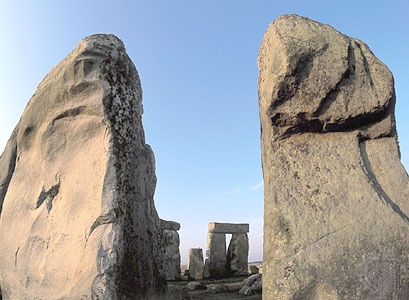
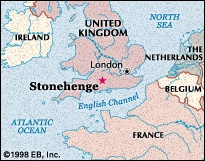
archaeological site located about 18.5 miles (30 km) south of the Avebury site and 8 miles (13 km) northwest of Salisbury, in Wiltshire, England. Built in prehistoric times—the digging of ditches began about 3100 BC—it is a monumental circular setting of large standing stones surrounded by an earthwork.
The Stonehenge (World Heritage site) that visitors see today is considerably ruined, many of its stones having been pilfered by medieval and early modern builders (there is no natural building stone within 13 miles 【21 km】 of Stonehenge); its general architecture has also been subjected to centuries of weathering. The monument consists of a number of structural elements, mostly circular in plan. On the outside is a circular ditch, with a bank immediately within it, all interrupted by an entrance gap on the northeast, leading to a straight path called the Avenue. At the centre of the circle is a stone setting consisting of a horseshoe of tall uprights of sarsen (Tertiary sandstone) encircled by a ring of tall sarsen uprights, all originally capped by horizontal sarsen stones in a post-and-lintel (post-and-lintel system) arrangement. Within the sarsen stone circle were also configurations of smaller and lighter bluestones (igneous rock of diabase, rhyolite, and volcanic ash), but most of these bluestones have disappeared. Additional stones include the so-called Altar Stone, the Slaughter Stone, two Station stones, and the Heel Stone, the last standing on the Avenue outside the entrance. Small circular ditches enclose two flat areas on the inner edge of the bank, known as the North and South barrows, with empty stone holes at their centres.
The modern interpretation of the monument is based chiefly on excavations carried out since 1919 and especially since 1950. Archaeological excavations in the latter part of the 20th century suggest three main periods of building—Stonehenge I, II, and III, the last divided into phases.
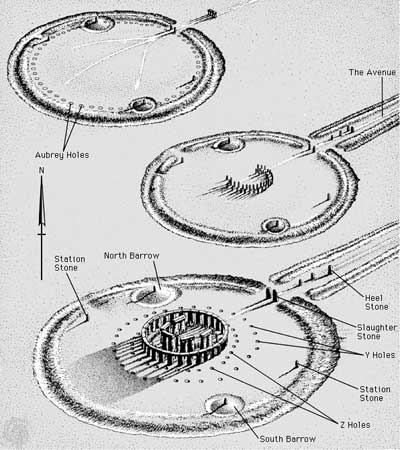 In Stonehenge I, about 3100 BC, the native Neolithic (Neolithic Period) people, using deer antlers for picks (the carbon-14 dating of which has helped to date the monument), excavated a roughly circular ditch about 320 feet (98 metres) in diameter; the ditch was about 20 feet (6 metres) wide and 4.5 to 7 feet (1.4 to 2 metres) deep, and the excavated chalky rubble was used to build the high bank within the circular ditch. Two parallel entry stones on the northeast of the circle were also erected (one of which, the Slaughter Stone, still survives). Just inside the circular bank they also dug—and seemingly almost immediately refilled—a circle of 56 shallow holes, named the Aubrey Holes (for their discoverer, the 17th-century antiquarian John Aubrey (Aubrey, John)). The Station stones also probably belong to this period, but the evidence is inconclusive. In addition, a timber henge (circle) may have been erected at the site.
In Stonehenge I, about 3100 BC, the native Neolithic (Neolithic Period) people, using deer antlers for picks (the carbon-14 dating of which has helped to date the monument), excavated a roughly circular ditch about 320 feet (98 metres) in diameter; the ditch was about 20 feet (6 metres) wide and 4.5 to 7 feet (1.4 to 2 metres) deep, and the excavated chalky rubble was used to build the high bank within the circular ditch. Two parallel entry stones on the northeast of the circle were also erected (one of which, the Slaughter Stone, still survives). Just inside the circular bank they also dug—and seemingly almost immediately refilled—a circle of 56 shallow holes, named the Aubrey Holes (for their discoverer, the 17th-century antiquarian John Aubrey (Aubrey, John)). The Station stones also probably belong to this period, but the evidence is inconclusive. In addition, a timber henge (circle) may have been erected at the site.Stonehenge I was used for about 500 years and then reverted to scrubland.
During Stonehenge II, about 2300 BC, the complex was radically remodeled. About 80 bluestone pillars, weighing up to 4 tons each, were erected in the centre of the site to form what was to be two concentric circles, though the circles were never completed. (The bluestones came from the Preseli Mountains in southwestern Wales and were either transported directly by sea, river, and overland—a distance of some 240 miles 【385 km】—or were brought in two stages widely separated in time.) The entranceway of this setting of bluestones was aligned approximately upon the sunrise at the summer solstice, the alignment being continued by a newly built and widened approach (the Avenue), together with a pair of Heel stones. The double circle of bluestones was dismantled in the following period.
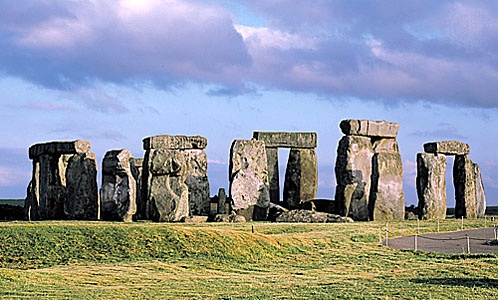 The initial phase of Stonehenge III, starting about 2000 BC, was when the linteled circle and horseshoe of large sarsen stones were erected, the remains of which can still be seen today. The sarsen stones were transported from the Marlborough Downs 20 miles (30 km) to the north and were erected in a circle of 30 uprights (only 17 of which are still standing) capped by a continuous ring of stone lintels. Within this ring was erected a horseshoe formation of five trilithons, each of which consisted of a pair of large stone uprights supporting a stone lintel. The sarsen stones are of exceptional size, up to 30 feet (9 metres) long and 50 tons (4,860 kg) in weight. Their visible surfaces were laboriously dressed smooth by pounding with stone hammers; the same technique was used to form the mortise-and-tenon (dovetail) joints by which the lintels are held on their uprights, and it was used to form the tongue-and-groove joints by which the lintels of the circle fit together. The lintels are not rectangular, being curved to produce all together a circle. The pillars are tapered upward. The jointing of the stones is probably an imitation of contemporary woodworking.
The initial phase of Stonehenge III, starting about 2000 BC, was when the linteled circle and horseshoe of large sarsen stones were erected, the remains of which can still be seen today. The sarsen stones were transported from the Marlborough Downs 20 miles (30 km) to the north and were erected in a circle of 30 uprights (only 17 of which are still standing) capped by a continuous ring of stone lintels. Within this ring was erected a horseshoe formation of five trilithons, each of which consisted of a pair of large stone uprights supporting a stone lintel. The sarsen stones are of exceptional size, up to 30 feet (9 metres) long and 50 tons (4,860 kg) in weight. Their visible surfaces were laboriously dressed smooth by pounding with stone hammers; the same technique was used to form the mortise-and-tenon (dovetail) joints by which the lintels are held on their uprights, and it was used to form the tongue-and-groove joints by which the lintels of the circle fit together. The lintels are not rectangular, being curved to produce all together a circle. The pillars are tapered upward. The jointing of the stones is probably an imitation of contemporary woodworking.In the second phase of Stonehenge III, which probably followed within a century, about 20 bluestones from Stonehenge II were dressed and erected in an approximate oval setting within the sarsen horseshoe. Sometime later, about 1550 BC, two concentric rings of holes (the Y and Z Holes, today not visible) were dug outside the sarsen circle; the apparent intention was to plant upright in these holes the 60 other leftover bluestones from Stonehenge II, but the plan was never carried out. The holes in both circles were left open to silt up over the succeeding centuries. The oval setting in the centre was also removed.
The final phase of building in Stonehenge III probably followed almost immediately. Within the sarsen horseshoe the builders erected a horseshoe of dressed bluestones set close together, alternately a pillar followed by an obelisk followed by a pillar and so on. The remaining unshaped 60-odd bluestones were set as a circle of pillars within the sarsen circle (but outside the sarsen horseshoe). The largest bluestone of all, traditionally misnamed the Altar Stone, probably stood as a tall pillar on the axial line.
About 1100 BC the Avenue was extended from Stonehenge eastward and then southeastward to the River Avon (Avon, River), a distance of about 9,120 feet (2,780 metres). This suggests that Stonehenge was still in use at the time.
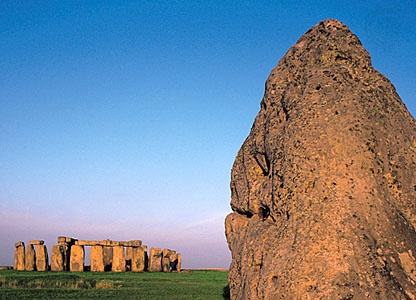 Why Stonehenge was built is unknown, though it probably was constructed as a place of worship of some kind. Notions that it was built as a temple for Druids (Druid) or Romans (ancient Rome) are unsound, because neither was in the area until long after Stonehenge was last constructed. Early in the 20th century, the English astronomer Sir Joseph Norman Lockyer (Lockyer, Sir Joseph Norman) demonstrated that the northeast axis aligned with the sunrise at the summer solstice, leading other scholars to speculate that the builders were sun worshipers. In 1963 an American astronomer, Gerald Hawkins, purported that Stonehenge was a complicated computer for predicting lunar and solar eclipses. These speculations, however, have been severely criticized by most Stonehenge archaeologists. “Most of what has been written about Stonehenge is nonsense or speculation,” said R.J.C. Atkinson, archaeologist from University College, Cardiff. “No one will ever have a clue what its significance was.”
Why Stonehenge was built is unknown, though it probably was constructed as a place of worship of some kind. Notions that it was built as a temple for Druids (Druid) or Romans (ancient Rome) are unsound, because neither was in the area until long after Stonehenge was last constructed. Early in the 20th century, the English astronomer Sir Joseph Norman Lockyer (Lockyer, Sir Joseph Norman) demonstrated that the northeast axis aligned with the sunrise at the summer solstice, leading other scholars to speculate that the builders were sun worshipers. In 1963 an American astronomer, Gerald Hawkins, purported that Stonehenge was a complicated computer for predicting lunar and solar eclipses. These speculations, however, have been severely criticized by most Stonehenge archaeologists. “Most of what has been written about Stonehenge is nonsense or speculation,” said R.J.C. Atkinson, archaeologist from University College, Cardiff. “No one will ever have a clue what its significance was.”Stonehenge and the nearby circular monument of Avebury were collectively added to UNESCO's World Heritage List (World Heritage site) in 1986.
Additional Reading
R.J.C. Atkinson, Stonehenge (1956, reissued 1990), is an early study of the site. Christopher Chippindale, Stonehenge Complete, rev. ed. (1994), introduces the monument and studies of it. John North, Stonehenge (1996), provides a new interpretation of Stonehenge and surrounding sites based on astronomical observation. David Souden, Stonehenge Revealed (also published as Stonehenge, 1997), discusses the mysteries of the site.
- Louis Marie Anne Couperus
- Louis-Marie de La Révellière-Lépeaux
- Louis-Marie Noailles, vicomte de
- Louis-Marie-Olivier Duchesne
- Louis-Marie, vicomte de Noailles
- Louis, marquis de Fontanes
- Louis Marshall
- Louis-Mathieu, Comte Molé
- Louis-Mathieu Molé, Comte
- Louis Moreau Gottschalk
- Louis, Morris
- Louis-Nicholas Clérambault
- Louis-Nicolas Ménard
- Louis Noailles, 4e duc de
- Louis of Nassau
- Louis Orléans, duc d'
- Louis Pasteur
- Louis-Paul Cailletet
- Louis-Philippe
- Louis-Philippe, duc d' Orléans
- Louis-Philippe-Joseph, duc d' Orléans
- Louis-Philippe-Joseph Orléans, duc d'
- Louis-Philippe Orléans, duc d'
- Louis-Philippe-Robert, duc d' Orléans
- Louis-Philippe-Robert Orléans, duc d'